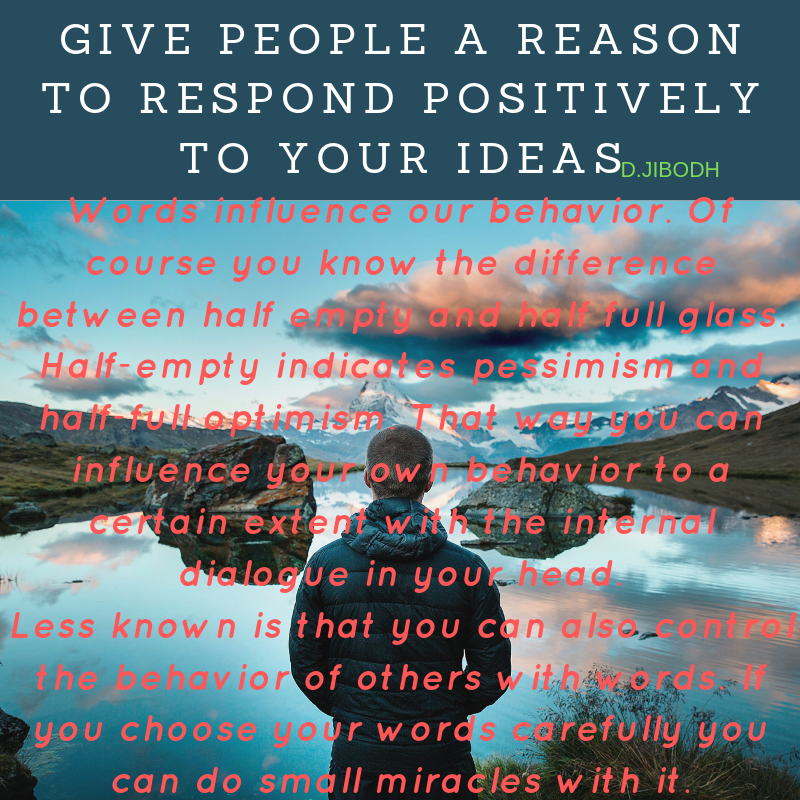

The Brutal Simplicity of Words
Since its appearance at the end of the last century, positive psychology has greatly influenced a significant number of all the conceptual and theoretical models developed in the field of psychology.
Psychology progressively stopped focusing on what makes us unhappy and unproductive, focusing instead on what mitigates suffering and increases people’s happiness and positive outcomes.
In parallel, organizational behavior is applying as an extension, the principles of positive psychology. The scientific community on organizational behavior is focusing on the study of positive organizational behavior structures and formulas to ensure the success of economic, political, and organizational systems leading to a positive optimization of processes and results.
And positive leadership is one of the most vital factors within positive organizational psychology. The flourishment of all the positive dimensions of the human being and the promotion of organizational and occupational well-being and health, both at the individual and collective levels.
But what does it take to be a positive leader? What makes it somehow different from regular leadership?
According to Wooten, L. P. and Cameron, K. S. in their article “Enablers of a Positive Strategy: Positively Deviant Leadership,” positive leaders are those whose behaviors show an orientation towards the positive extreme, based on the existence of a continuum, on which any leader can be situated. Under this light, positive leadership has specifically, three necessary components:A focus on people’s strengths and abilities that reaffirm their human potential;An emphasis on results and facilitates above the average individual and organizational performance;A field of action concentrated on the components that can be seen as essential virtues of the human condition.
The conceptual framework of positive leadership has deepened into different forms of positive leaders (transformational, servant, spiritual, authentic, and ethical). With a common denominator on the priority of encouraging and maintaining optimal levels on followers’ performance, through the promotion of virtuous and eudaimonic behaviors, Avolio B. J. and Gardner, W. L. have also identified five common components to all these forms: a positive moral outlookleader’s self-knowledgepositive modeling of the followers’ behaviorpersonal and social identification of followers with the leader and the grouppositive social exchanges between the leader and the followers.
1. Transformational leadership
The model of “transformational leadership” was introduced for the first time as opposed to the traditional concept of the “transactional leader” as the one formulating the exchange of rewards contingent to the followers producing several desired behaviors.
Transformational leaders otherwise are described as capable of motivating their followers to transcend their own individual interests, to guide their behavior to achieve collective goals.
According to Bernard M. Bass in his study on the field, the transformational leader integrates four essential factors: idealized influence, inspirational motivation, intellectual stimulation, and the individualized consideration of the followers. Bass extensive studies on the field have led to the development of the Multifactor Leadership Questionnaire much used for understanding the effectiveness of leaders in organizations. There is extensive research on empirical evidence pointing out how behaviors related to transformational leadership have a positive effect on individual and group variables, such as employee engagement, motivation and the efficient execution of tasks as well as variables related to the overall organizational effectiveness and performance of a company.
2. Servant Leadership
According to its conceptual father Robert K. Greenleaf, the servant leader is one who places the needs, aspirations, and interests of his followers over his own; the deliberate choice is to serve others to achieve their development and the success of the organization. This way, the theory of servant leadership emphasizes the concept of service to others and the recognition that the role of the organization is to enable the formation of individuals who can help create a positive organizational environment.
3. Spiritual Leadership
Inspired by the ideas of Greenleaf and a context in which conventional leadership is not sufficient to meet the needs of individuals in the organizational environment, Gilbert W. Fairholm defined in 1996 the theory and model of “spiritual leadership.” Based on a number of identified qualities such as the presence of set life goals, deeply rooted moral convictions, high intellectual ability, social skills and a unique orientation to the development of values in others, this model incorporates elements associated with the capabilities, needs and interests of both the leader and their followers, as well as the objectives and goals of the organization.
4. Authentic Leadership
Avolio and Gardner, the most prominent authors of this field, defined authentic leaders as those endowed with deep moral convictions, whose behavior is strongly inspired by these ethical principles for the benefit of the group. Greatly aware of their thoughts, emotions, skills, value system and perception by others, they possess high doses of confidence, optimism, hope, resilience, and moral strength and avoid behaving inconsistently even when these might be uncomfortable for their followers. Authentic leadership theory and model emerged in response to the many examples of unethical behavior experienced on the that have political and business environment.
Authentic leaders have positive psychological capital, moral perspective, self-knowledge, and self-regulation of behavior. They are characterized by a positive process of influence with easiness for personal and social identification, modeling positive behavior, emotional contagion, and social exchange based on reciprocity and consistency. Through closeness and exposure to authentic leaders, the followers develop self-awareness, self-regulation, and personal flourishment. And it is the interaction of all these components what creates a sustainable organizational competitive advantage with positive psychological results for all its members.
5. Ethical Leadership
Despite the ethical dimensions being present in the transformational, servant, and especially the authentic model of leadership, some authors are trying to develop the concept of ethical leadership as an independent construct. Still, under in-depth research, ethical leadership seeks to promote normatively appropriate behaviors, in the followers, through personal actions and interpersonal relationships between them and the leader, using a reward system and transparent communication.
Dear Readers,
As the Caribbean Blog Authority, I am making an exception to write this blog.With this blog I like to reach policymakers/governments from the total Caribbean region so they can start to prepare for what is coming. Read further and feel free to share this information.
The Pan-American health organization (PAHO) has urged the Caribbean countries to prepare for heat waves. While Europe is experiencing heat waves, North America, Central America and the Caribbean are also at risk. The situation could deteriorate between July and August, with a negative impact on human health, says the PAHO.
Given the current heat waves in Europe and the predictions that this phenomenon will affect different parts of America, the PAHO urges countries in the region to prepare. The organization warns of the impact that the heat waves could have on people’s health, including the risk of death.
During the summer of the southern hemisphere of 2018-2019, seven countries in North and South America (Argentina, Brazil, Chile, Mexico, Paraguay, Peru and Uruguay) were hit by heat waves, a phenomenon that has never been in the region before perceived. The heat waves that had the greatest impact since 2000 were those in Brazil that caused the death of 737 people in 2010, and those in Argentina in the summer of 2013-2014 that caused 1,877 deaths. The heat in Argentina left 800,000 people without energy, which increased the heat stress in this group. According to health authorities in the United States, heat waves are the natural phenomenon that causes the highest number of deaths in that country.
Weather forecasts for North America, Central America and the Caribbean predict heat waves during the summer (July / August) of 2019. This can cause drought-induced stress, lead to forest fires and have harmful effects on human health.
Due to the situation, the PAHO has developed a guide to help countries in the region formulate emergency plans to tackle heat waves. This guide provides recommendations that the health sector and meteorological authorities can implement to prepare for and better respond to this threat, promote health, prevent the harmful effects of heat waves, treat affected people and save lives.
The document emphasizes that emergency plans for emergencies must be able to determine the extent of the threat, with activation procedures for alerts, a description of roles and functions, and coordination mechanisms within and between authorities. The document also emphasizes that countries need to strengthen the epidemiological surveillance of heat-related morbidity and mortality, the capacity of health services (staff training, improvements in the design of new hospitals and equipment of existing hospitals in high-risk areas). Improving the actions of local authorities, the media and communities in terms of response measures between agencies, prevention measures and self-care should be improved.
Heat exposure causes serious symptoms such as heat exhaustion and heat stroke (a condition that causes faintness, as well as dry, warm skin, due to the body’s inability to control high temperatures). Most heat-related deaths are due to deterioration of the circulatory system, kidney, hormonal, and psychiatric disorders. Other symptoms include fluid retention in the lower limbs, heat rashes in the neck, cramps, headache, irritability, lethargy and weakness.
People with chronic illnesses who take medication on a daily basis run a greater risk of complications and death during a heat wave, as well as the elderly and children.
To prevent the harmful effects of heat, the PAHO recommends:
– Stay informed of weather warnings and forecasts;
– Avoid sun exposure between 11 o’clock in the morning and 4 o’clock in the afternoon;- Do not leave children or elderly people in parked vehicles;
– Do not train or do intense outdoor activities without proper protection;- Drink water every 2 hours, even if you are not thirsty;
– Keep the house cool by covering windows during the day and using air conditioners or fans during the hottest hours.
– If you have a chronic illness and are taking medication, consult your doctor.
For people who would like to improve on a personal level, there is a widely used Japanese method: Kaizen. Kaizen revolves around the small steps that must be taken to realize the biggest plans. AllTopStartup founder Thomas Oppong puts it this way: “Getting one percent better every day is a simple, practical way to achieve big goals.”
Kaizen spread to the rest of the world thanks to American experts such as Frank Bunker Gilbreth and Frederick Winslow Taylor. They were already at the forefront of research into effective work in the 1920s and their knowledge was the basis for Kaizen. In post-war Japan, a way was sought to increase the effectiveness of employees. This way was found in the idea of Kaizen, freely translated: good change, or continuous improvement.
Kaizen has a goal that goes beyond just improvement. It is a daily activity and a process that can make people more human. It eliminates unnecessary work and teaches people to see wastes and remove them. A commonly used definition is ‘disassembly and reassembly in a better way’. What is taken apart is usually a process, system, or service in a company. In personal development, an action or habit will be reassembled.
Continuous improvement works by sticking to three conditions. Set a goal for one percent improvement. Decide how often you will work on the goal and stick to that plan, focus on the one percent improvement. Stay with this process until you reach the end goal. By not focusing on the end goal but on the one percent goal, improvement can be achieved in an easily accessible manner. By working in small steps you build a solid foundation for a great future.